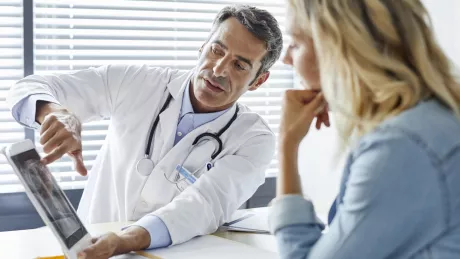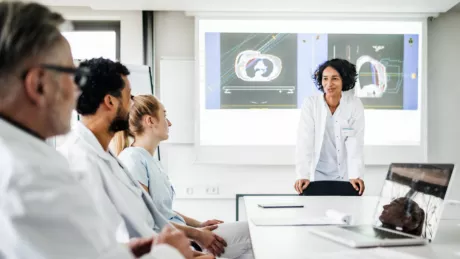
Telemedicine: More than just a virtual visit to the doctor’s office
published on 11.05.2020
Is there anyone who enjoys waiting around at a doctor's office? Waiting costs valuable time, carries the risk of infection – and travelling to the doctor’s office is additionally hard on patients who are already ill.
Demand for telemedicine on the rise
Due to the corona crisis, many people are unwilling to see a doctor despite being ill. Some are afraid of infection, while others are – often unnecessarily – worried that their complaints are not serious enough given the current situation. If you call one of the official hotlines with questions about corona, you will certainly need to be patient. And even without a pandemic, it is still sometimes difficult to communicate with doctors – for instance, due to the few doctors in many rural areas. So, the obvious question is: What are the digital alternatives and initiatives?
The Digital Supply Act (DVG), which came into force on 19 December 2019, has paved the way for the use of telemedicine. This means that everyone in Germany with statutory health insurance is entitled to care through digital health apps (DiGA). The number of specialized video service providers and their services is growing. And more and more regular doctor’s offices are offering telemedicine.
It goes without saying that online consultations are not designed to replace face-to-face care. They are also not suitable for treating serious diseases. But they can be useful for an initial assessment and replace many short visits that involve waiting around for hours. Due to its many and varied application possibilities, telemedicine is a useful addition to medical care and treatment of patients.
Online consultation and ePrescription – Convenient from the comfort of home
Once the patient has installed an app of their choice on their smartphone, tablet or PC, they can easily make an appointment for an online consultation with a suitable doctor. All you need for a consultation is a headset with microphone and a stable Internet connection. After the online consultation, the doctor can issue an electronic prescription, sign it digitally and send it to the patient’s pharmacy. The pharmacy can immediately access the ePrescription, process it and then send the medication to the patient’s home. The German government plans to make ePrescriptions mandatory nationwide from January 2022 and a corresponding app is to be made available in 2021.
Telemonitoring supports therapies and treatments
Telemedicine has many more advantages for patients, doctors and pharmacists. With so-called telemonitoring – be it via an app or using other digital medical devices – the patient can easily transfer relevant measurement data digitally to the attending physician. As of this year, doctors can even officially prescribe useful apps, for instance, for determining the blood sugar levels of diabetics, measuring blood pressure or simply as a reminder to take medication.
In addition, physicians can provide support for special therapies, aftercare and rehabilitation, as in cardiology and psychotherapy. In the context of teleradiology, physicians can digitally access X-ray or CT images. In the so-called teleconsultation-based evaluation of findings, several physicians can network to jointly evaluate radiological examinations and then initiate further steps if necessary.
High security requirements for telemedicine applications
When using telemedicine applications, users must always be able to rely on the fact that the software used and the digital communication link meet the legislator’s high security requirements. Technology must treat patient concerns in the strictest confidence – just as a physician would. So-called certification authorities check whether providers of telemedicine apps and video services meet these high standards for data and security. Only those providers who meet all conditions are issued with a valid test certificate. The telematics infrastructure (TI) – the digital health network for Germany – is designed to ensure the security of patient data. Only registered users from the healthcare professions with special digital IDs can access this specially secured digital data platform which serves as the basis for telemedicine applications. End-to-end encryption is used for communication. Physicians need the SMC-B card (Security Module Card for medical practices) to log into the TI and can then exchange patient files with other physicians and hospitals or send an ePrescription to the pharmacy. If the physician has both the SMC-B card and the electronic Health Professional Card (eHPC) – both of which are available from Bundesdruckerei’s subsidiary D‑TRUST –, the physician will then be able to digitally sign medical documents, for instance, the electronic doctor’s letter. These digital exchange solutions save a lot of time for all those involved.
Legal requirements now fulfilled – Telemedicine picks up speed
In recent years, legislators, doctors and patients’ associations as well as statutory health insurance companies have introduced important rules concerning the use and expansion of telemedicine. In its ‘Future Health’ study, auditing and consulting firm PwC already saw telemedicine on the verge of a breakthrough in 2018. And according to Dr. Florian Weiß, managing director of telemedicine provider jameda, the number of online consultations has recently increased six-fold in just a few weeks. This was also confirmed in a recent Civey survey commissioned by the Tagesspiegel newspaper, according to which the vast majority of Germans now use telemedicine. What is now needed throughout Germany are good and stable networks for digital communications, especially if we are to avoid moving the waiting room at a doctor’s office to the patient’s living room.







